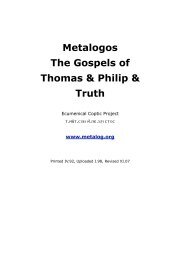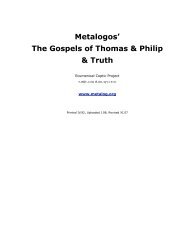Andrew Louth - Syriac Christian Church
Andrew Louth - Syriac Christian Church
Andrew Louth - Syriac Christian Church
Create successful ePaper yourself
Turn your PDF publications into a flip-book with our unique Google optimized e-Paper software.
14 INTRODUCTION<br />
nature of the theological agreement achieved in terms drawn from the<br />
Psephos, with its uncontroversial assertion of the unity of Christ’s<br />
divine subject, which excluded two contrary wills, and in fact made it<br />
unnecessary to count the ‘activities’ of Christ. In his reply, Honorius<br />
warmly congratulated those who had achieved such reconciliation in<br />
the East, and went on to clarify the nature of the theological<br />
agreement achieved, concluding with a confession of ‘the one will of our<br />
Lord Jesus Christ’: the refinement of Monenergism known as<br />
‘Monothelitism’. It was the doctrine of Monothelitism that was<br />
enshrined in the imperial edict, drafted by Sergius and signed by<br />
Heraclius in 638: the Ecthesis. In that same year Sergius died, to be<br />
succeeded by Pyrrhus, who, as abbot of the monastery of Chrysopolis,<br />
had helped in the drafting of the Ecthesis.<br />
Elected Patriarch of Jerusalem in 634, Sophronius, following custom,<br />
issued a Synodical Letter to be sent to the other patriarchs as evidence<br />
of his orthodoxy. Although this letter accepts the authority of the<br />
Psephos in so far as it does not literally ‘count’ the activities of Christ,<br />
it argues against Monenergism, as entailing Monophysitism. The<br />
Ecthesis, in fact, served as a response to Sophronius’ Synodical Letter<br />
which Sergius refused to accept. In Rome, however, Sophronius seems<br />
to have found a more sympathetic ear: only fragments of the Pope’s<br />
second letter to Sergius have survived, and it seems that there is a<br />
retreat from Monothelitism. Honorius died in 638, before he had a<br />
chance to accept or reject the Ecthesis. It was more than a year before<br />
his immediate successor, Severinus, was consecrated, owing to his<br />
resistance to accepting the Ecthesis: the brutal treatment he received<br />
from the imperial exarch was doubtless the reason why his reign in<br />
640 lasted barely a few months. Popes John IV (640–2) and Theodore<br />
I (642–9) both rejected the Ecthesis.<br />
But Heraclius’ efforts to consolidate his reconquest of the Byzantine<br />
provinces in the Middle East were frustrated even as it seemed that<br />
he was succeeding. For, as we have already seen, in the course of the<br />
630s and 640s both the Byzantine and the Persian Empires were<br />
shaken by an invasion from the south, from the deserts of Arabia.<br />
What lay behind this invasion from the south is shrouded in mystery.<br />
The conventional story is that many of the Bedouin tribes of the<br />
Arabian desert had found a militant unity under the new religion of<br />
Islam, preached by Muhammed, who died in 632. Be that as it may,<br />
one by one the cities of the Middle East fell to the Arab armies:<br />
Damascus in 635, Jerusalem in 638 (surrendered by the Patriarch<br />
Sophronius), the Persian Empire crumbled in the 640s, Alexandria<br />
was taken in 642 and despite several attempts the Byzantines were<br />
never able to regain it. In a very few years the Eastern provinces of<br />
the Byzantine Empire were lost for good.




